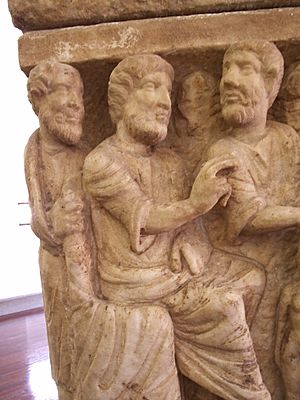Dogmatic Sarcophagus facts for kids
The Dogmatic Sarcophagus, also known as the "Trinity Sarcophagus," is an ancient stone coffin from the early Christian period. It was made between the years 320 and 350 AD and is now displayed in the Vatican Museums. The sarcophagus was found in the 1800s during work on the basilica di San Paolo fuori le Mura in Rome, Italy.
This sarcophagus is a very important example of Christian-Roman art from the time of Emperor Constantine I. Its name comes from the way its carvings show important Christian beliefs, or dogmas. These beliefs were discussed at the Council of Nicaea in 325 AD.
One key belief shown is that Jesus Christ is equal to God the Father. This is seen in a carving where a figure who looks like Jesus stands between Adam and Eve. The carving shows a central idea of the Christian faith in art.
Contents
Description of the Carvings
The front of the sarcophagus is divided into two rows, or registers, of carvings. This was a common style at the time. The carvings show stories from both the Old Testament and the New Testament.
In the center, there is a shell-shaped circle called a clipeus. Inside it are carvings of the man and woman who were buried in the sarcophagus. They are shown hugging and wearing clothes that were fashionable in the 4th century. The faces are very simple and not detailed, which might mean the artists did not have time to make them look like the real people.
The Top Row of Carvings
The top row shows five different scenes. Two are from the Book of Genesis and three are miracles performed by Jesus.
- The Creation of Eve: Three bearded figures, representing the Trinity, are shown. The one in the middle is creating Eve from the rib of Adam, who is lying on the ground.
- Adam and Eve: A younger figure who looks like Jesus stands between Adam and Eve near the Tree of the Knowledge of Good and Evil.
- Marriage at Cana: Jesus turns water into wine at a wedding.
- Multiplying the Loaves and Fish: Jesus feeds a huge crowd with only a small amount of food.
- Resurrection of Lazarus: Jesus brings Lazarus back to life.
The Bottom Row of Carvings
The bottom row has six scenes. One is about Jesus's birth, and others are about stories from the Bible and the life of Saint Peter.
- Adoration of the Magi: Three wise men, wearing eastern clothing, visit the baby Jesus and his mother, Mary.
- Healing the Blind: Jesus heals a man who cannot see.
- Daniel in the Lions' Den: Daniel is shown safe in a den full of lions.
- Habbakuk and the Angel: The prophet Habbakuk is shown with a basket of bread.
- Peter Denies Jesus: Peter is shown with a rooster, which crowed after he denied knowing Jesus.
- Peter's Arrest: Two soldiers arrest Peter.
- Water from the Rock: A scene showing either Moses or Peter striking a rock to make water flow out.
Based on the hairstyles and the simple, blocky style of the figures, experts believe the sarcophagus was made between 330 and 340 AD. Some think it was made by the same artists who worked on the famous Arch of Constantine in Rome.
The Meaning of the Pictures
The carvings on the sarcophagus are full of symbolism and meaning for Christians.
The Trinity in Creation
The Book of Genesis says that God created the world. However, early Christians believed that Jesus, as part of the Trinity, was also involved in creation. The scene showing three figures creating Eve is a picture of this belief. Showing scenes of miracles, like the Raising of Lazarus, next to scenes about creation was meant to give hope for a new life after death.
Adam and Jesus
In the Bible, Jesus is sometimes called the "new Adam." The carvings might be showing this connection. The scene with Adam, Eve, and a figure who looks like Jesus could represent the "division of labors," where the figure gives Adam a bundle of grain and Eve a hare (a type of rabbit). This might show the different roles they would have.
The story of Adam and Eve was also seen as a symbol for a faithful marriage. Since the sarcophagus was for a married couple, these scenes would have been very meaningful.
See also
 In Spanish: Sarcófago dogmático para niños
In Spanish: Sarcófago dogmático para niños


